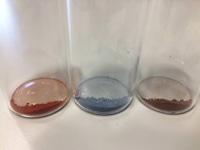Jun 30 2017
Researchers in the Energy Safety Research Institute (ESRI) at Swansea University have developed a novel composite material that has potential as a catalyst for the degradation of environmentally-harmful artificial dye pollutants, which are released at a rate of closely 300,000 tons annually into the world’s water.
 Powders of tantalum nitride nanoparticles (left), tungsten oxide nanowires (center) and the tantalum nitride/tungsten oxide composite (right). (Credit: Daniel Jones/University of Swansea)
Powders of tantalum nitride nanoparticles (left), tungsten oxide nanowires (center) and the tantalum nitride/tungsten oxide composite (right). (Credit: Daniel Jones/University of Swansea)
This novel, non-harmful photocatalytic material successfully removes dye pollutants from water, adsorbing over 90 % of the dye and improving the rate of dye breakdown by nearly ten times using visible light.
The Researchers, guided by Dr. Charles W. Dunnill and Dr. Daniel Jones at the Energy Safety Research Institute in Swansea University, published their discovery in the Nature open access journal Scientific Reports.
By heating the reaction mixture at high pressures within a sealed container, the composite is created by growing ultra-thin “nanowires” of tungsten oxide on the surface of minuscule particles of tantalum nitride. Due to the very small size of the two material components – both the tungsten oxide and tantalum nitride are usually less than 40 billionths of a meter in diameter – the composite offers a large surface area for dye capture.
The material then continues to break the dye down into smaller, harmless molecules using the energy provided by sunlight, in a process termed as “photocatalytic degradation”. Now that the harmful dyes have been removed, the catalyst may just be filtered from the cleaned water and reused.
While the photocatalytic degradation of dyes has been studied for a number of decades, it is only fairly recently that Researchers have developed materials that can absorb the visible part of the solar spectrum – other materials, such as titanium dioxide, are also capable of breaking down dyes using solar energy, but their efficiency is minimal as they only absorb higher energy, UV light. By making use of a much stronger range of the spectrum, materials such as those used by the ESRI team at Swansea University are able to eliminate pollutants at a far greater rate.
Both of the materials used in the research have attracted considerable interest in the last few years. Tungsten oxide, especially, is thought to be one of the most promising materials for a range of photocatalytic applications, because of its chemical stability, high electrical conductivity, and surface activity, along with its strong light absorbance. As a low band-gap semiconductor, tantalum nitride is red in color as a result of its ability to absorb nearly the whole spectrum of visible light, and thus extracts a high quantity of energy from sunlight to power the degradation processes.
However, the real potential of the two materials was only recognized once they were joined into a single composite. Because of the exchange of electrons between the two materials, the test dye used within the research was broken down by the composite at about double the rate accomplished by tantalum nitride on its own, while tungsten oxide alone was revealed to be incapable of dye degradation. In comparison to other leading photocatalytic materials, many of which are deadly to both humans and aquatic life, both parts of the composite are categorized as non-hazardous materials.
The researchers accountable for the study feel that their research offers just a taster of the material’s capacity.
Now that we’ve demonstrated the capabilities of our composite, we aim to not just improve on the material further, but to also begin work on scaling up the synthesis for real-world application. We’re also exploring its viability in other areas, such as the photocatalysed splitting of water to generate hydrogen.
Dr. Daniel Jones, Energy Safety Research Institute, Swansea University
Besides Drs. Dunnill and Jones, Co-Authors of the paper are Drs. Virginia Gomez, James McGettrick and Serena Margadonna and PhD students Bertrand Rome, Francesco Mazzali and Aled Lewis, who are all Fellow Researchers in the College of Engineering at Swansea University, in collaboration with Dr. Joseph Bear from the Materials Chemistry Centre at University College London and Dr. Waheed Al-Masry from the Department of Chemical Engineering at King Saud University, Saudi Arabia.